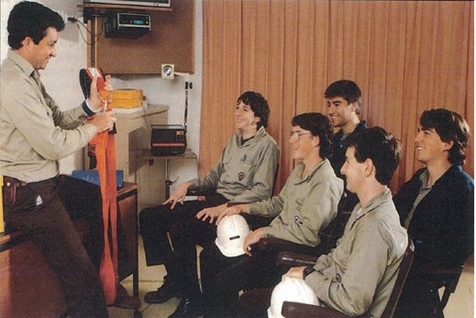Improving safety levels in the workplace is not a simple undertaking. Work-related injuries, and even fatalities, are recorded every year in every employment sector. But, with the introduction of the new WHS Act, this is hoped to dramatically reduce accidents at work.
It is an unfortunate fact that everyone faces potential hazards in:
- Place of work
- From stairwells
- Unstable shelving and scaffolding
- To machinery
- Tools and electrical cords
There are any number of ways in which we can suffer an injury.
The new WHS Act is a major undertaking, with an array of new duties and responsibilities for employers and their workers. So, it is only to be expected that Safe Work Australia would put together a guide to clarify what these new laws and regulations actually mean.
The guide is itself something of a major read, comprising more than 40 pages of detailed explanation that sheds light on the complexities of the Act. From the duties of PCBUs and other officers (including first aid requirements), to their requirement to consult with workers, to the rights inspectors have in enforcing the Act, a multitude of issues are clarified.
The guide also details the consequences faced by any company, PSBU, HSR or worker that fails to live up to their designated responsibilities. The maximum punishments include a fine of $3 million issued to guilty corporations, $600,000 and 5 years in prison for a PCBU or officer, and $300,000 and 5 years in prison for a worker.
It’s clear that through the WHS Act, government is determined to make Australia one of the safest countries to work in. Below, we have provided a taste of what is contained in the Guide To The WHS Act [1.3MB], but you can read it in full by simply clicking on the link and downloading the guide for yourself. For more information, visit the Safe Work Australia website.
Some Guide Facts
Introduction:
Nationally Harmonised Work Health and Safety Laws
The WHS Act like that of most other jurisdictions is based on the ‘model’ WHS Act developed by Safe Work Australia.
The aim is to provide all workers in Australia with the same standard of health and safety protection regardless of the work they do or where they work.
A stronger national approach means greater certainty for businesses (particularly those operating across state borders) and over time reduced compliance costs for business.
More consultation between businesses, workers and their representatives, along with clearer responsibilities will make workplaces safer for everyone.
The harmonised work health and safety laws apply in the majority of jurisdictions. For more information about whether they apply in your jurisdiction check with your local regulator.
Purpose of the WHS Act (section 3)
The WHS Act provides a framework to protect the health, safety and welfare of all workers at work and of other people who might be affected by the work. The WHS Act aims to:
- Protect the health and safety of workers and other people by eliminating or minimising risks arising from work or workplaces
- Ensure fair and effective representation, consultation and cooperation to address and resolve health and safety issues in the workplace
- Encourage unions and employer organisations to take a constructive role in improving work health and safety practices
- Assisting businesses and workers to achieve a healthier and safer working environment
- Promote information, education and training on work health and safety
- Provide effective compliance and enforcement measures, and
- Deliver continuous improvement and progressively higher standards of work health and safety
In furthering these aims regard must be had to the principle that workers and other persons should be given the highest level of protection against harm to their health, safety and welfare from hazards and risks arising from work as is reasonably practicable.
For these purposes ‘health’ includes psychological health as well as physical health.
Work Health and Safety Duties:
General Principles (sections 13-17)
The WHS Act sets out work health and safety duties for PCBUs, officers, unincorporated associations, government departments and public authorities including municipal governments, workers and other people at a workplace.
Coverage:
The WHS Act covers:
- People who carry out work in any capacity for a person conducting a business or undertaking including employees, contractors, subcontractors, self-employed persons, outworkers, apprentices and trainees, work experience students and volunteers who carry out work.
- Other people at a workplace like visitors and customers at a workplace.
The WHS Act does not cover ‘volunteer associations’ who do not employ anyone.
More information about volunteer organisations and volunteers is available on the Safe Work Australia website and from local work health and safety regulators.
Multiple and Shared Duties (sections 14-16)
A person may have more than one duty. For example the working director of a company has duties as an officer of the company and also as a worker.
More than one person may have the same duty. A duty cannot be transferred to another person.
If more than one person has a duty for the same matter each person retains responsibility and must discharge their duty to the extent to which the person has the capacity to influence and control the matter—disregarding any attempts to ‘contract out’ of their responsibility.
Example:
A labour hire company hires out its employees to ‘host employers’ to carry out work for them. Both the labour hire company and the ‘host employer’ owes a duty of care to those employees. In such cases both are fully responsible for meeting that duty to the extent to which they have capacity to influence and control the matter. It is not possible to ‘contract out’ work health and safety duties.
Example:
A principal contractor and a subcontractor for construction work must ensure, so far as is reasonably practicable, the provision of adequate facilities for the welfare of the workers carrying out the construction work. This does not mean that both are responsible for providing the facilities. One may provide the facilities with the other duty holder satisfying themselves that their duty is met because the facilities provided by the other duty holder fulfil their obligations.
Consultation with Workers and Representation of Workers:
Consultation With Workers (sections 47-49)
PCBUs must so far as reasonably practicable consult with workers who carry out work for the business or undertaking who are, or are likely to be, directly affected by a matter relating to health and safety. This includes giving workers a reasonable opportunity to express their views or raise issues about work health and safety at the workplace.
Consultation is a collaborative process between PCBUs and their workers. It involves sharing information about work health and safety and ensuring that views of workers are taken into account when making decisions about health and safety at the workplace. It does not require agreement to be reached.
If there is an agreed consultation procedure then the consultation must be in accordance with those procedures.
If an HSR represents workers the consultation must involve the HSR.
A PCBU must consult with workers and take their views into account when:
- Identifying hazards and assessing risks arising from work
- Proposing changes that may affect the health and safety of workers, and
- Whenever specifically required to do so under particular regulations
And when considering making decisions about:
- Ways to eliminate or minimise risks
- The adequacy of facilities for workers’ welfare at work
- Procedures for consulting with workers
- Procedures for resolving health and safety issues
- Procedures for monitoring the health of workers or workplace conditions, and
- How to provide health and safety information and training to workers
Views of workers must be taken into account when consulting under these provisions but there is no requirement for agreement to be reached.
Workers who have been consulted under these provisions must be advised of the outcome in a timely manner. There is no particular way this advice must be given—it could for example be given at a ‘toolbox’ meeting or posted as an intranet news item.
Representation and Participation of Workers
Workers are entitled to:
- Elect a health and safety representative if they wish to be represented by one
- Request the formation of a health and safety committee if they wish
- cease unsafe work in certain circumstances (see below for more information)
- Have health and safety issues at the workplace resolved in accordance with an agreed issue resolution procedure, and
- Not be discriminated against for raising health and safety issues
Offences and Penalties:
Health and Safety Duty Offences
The WHS Act provides for three categories of criminal offences for breach of health and safety duties. The maximum penalties are different depending on the category of the offence and whether the offender is an individual (e.g. a worker, or a PCBU), an officer (as defined) or a body corporate.
- Category 1 – a duty holder, without reasonable excuse, engages in conduct that recklessly exposes a person to a risk of death or serious injury or illness.
- Category 2 – a duty holder fails to comply with a health and safety duty that exposes a person to risk of death or serious injury or illness.
- Category 3 – a duty holder fails to comply with a health and safety duty.
Volunteers are not liable for a failure to comply with a health and safety duty except in their capacity as a worker (section 28) or other person at a workplace (section 29).
An unincorporated association is not liable for prosecution although its officers (except volunteers) may be prosecuted for a failure to comply with an officer’s duty (section 27). Its members may owe duties in their capacities as workers (section 28) or other persons at a workplace (section 29).
Penalties for Breach of Health and Safety Duty Offences
| Type Order | Information | ||
| Corporation | Individual as PCBUor officer | Individual as workeror other | |
| Category 1 | $3 million | $600 000, five yearsin jail or both | $300 000, fiveyears jail or both |
| Category 2 | $1.5 million | $300 000 | $150 000 |
| Category 3 | $500 000 | $100 000 | $50 000 |
Alternative Penalty Options
In addition to imposing a penalty courts may impose alternative remedies including:
- Adverse publicity orders
- Restoration orders
- Work health and safety project orders
- Court-ordered work health and safety undertakings
- Injunctions, and
- Training orders
Alsco First Aid
We all know that time is very important especially in saving lives. Understanding our customer’s needs identified a need not only for training courses but the ability to manage and maintain the total compliancy of certifications, and aspects of legislation over and above just training. Alsco’s Managed Training Service is a complete solution that will compel action within your business.
Our Training Guarantee ensures you manage your training costs irrespective of staff turnover. Talk to an Expert! Our representatives are waiting for your call.
Image courtesy: Ausgrid photos


LEAVE A REPLY
Your email address will not be published. Required fields are marked *
You must be logged in to post a comment.